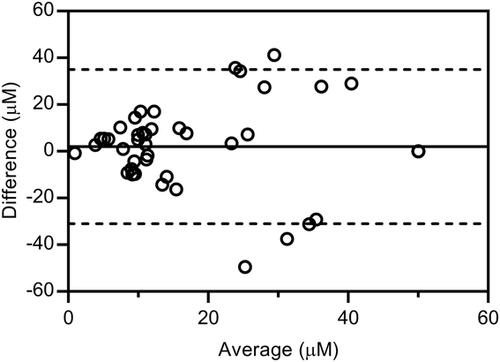Samantha J. Allen, Corey M. Dower, Annie X. Liu, Kevin J. Lumb
{"title":"Detection of Small-Molecule Aggregation with High-Throughput Microplate Biophysical Methods","authors":"Samantha J. Allen, Corey M. Dower, Annie X. Liu, Kevin J. Lumb","doi":"10.1002/cpch.78","DOIUrl":null,"url":null,"abstract":"<p>Small-molecule drug discovery can be hindered by the formation of aggregates that act as non-selective inhibitors of drug targets. Such aggregates appear as false positives in high-throughput screening campaigns and can bedevil structure-activity relationships during compound optimization. Protocols are described for resonant waveguide grating (RWG) and dynamic light scattering (DLS) as microplate-based high-throughput approaches to identify compound aggregation. Resonant waveguide grating and dynamic light scattering give equivalent results for the compound test set, as assessed with Bland-Altman analysis. © 2019 The Authors.</p><p><b>Basic Protocol 1</b>: Resonant waveguide grating (RWG) in 384-well or 1536-well plate format to detect compound aggregation</p><p><b>Basic Protocol 2</b>: Dynamic light scattering (DLS) in 384-well plate format to detect compound aggregation</p>","PeriodicalId":38051,"journal":{"name":"Current protocols in chemical biology","volume":"12 1","pages":""},"PeriodicalIF":0.0000,"publicationDate":"2020-03-09","publicationTypes":"Journal Article","fieldsOfStudy":null,"isOpenAccess":false,"openAccessPdf":"https://sci-hub-pdf.com/10.1002/cpch.78","citationCount":"3","resultStr":null,"platform":"Semanticscholar","paperid":null,"PeriodicalName":"Current protocols in chemical biology","FirstCategoryId":"1085","ListUrlMain":"https://onlinelibrary.wiley.com/doi/10.1002/cpch.78","RegionNum":0,"RegionCategory":null,"ArticlePicture":[],"TitleCN":null,"AbstractTextCN":null,"PMCID":null,"EPubDate":"","PubModel":"","JCR":"Q3","JCRName":"Biochemistry, Genetics and Molecular Biology","Score":null,"Total":0}
引用次数: 3
Abstract
Small-molecule drug discovery can be hindered by the formation of aggregates that act as non-selective inhibitors of drug targets. Such aggregates appear as false positives in high-throughput screening campaigns and can bedevil structure-activity relationships during compound optimization. Protocols are described for resonant waveguide grating (RWG) and dynamic light scattering (DLS) as microplate-based high-throughput approaches to identify compound aggregation. Resonant waveguide grating and dynamic light scattering give equivalent results for the compound test set, as assessed with Bland-Altman analysis. © 2019 The Authors.
Basic Protocol 1: Resonant waveguide grating (RWG) in 384-well or 1536-well plate format to detect compound aggregation
Basic Protocol 2: Dynamic light scattering (DLS) in 384-well plate format to detect compound aggregation

高通量微孔板生物物理方法检测小分子聚集
小分子药物的发现可能会被聚集物的形成所阻碍,这些聚集物作为药物靶点的非选择性抑制剂。这种聚合体在高通量筛选活动中出现假阳性,并可能在化合物优化过程中困扰结构-活性关系。描述了共振波导光栅(RWG)和动态光散射(DLS)作为基于微板的高通量方法来识别化合物聚集的协议。谐振波导光栅和动态光散射对复合测试集给出了等效的结果,用Bland-Altman分析进行了评估。©2019作者。基本协议1:384孔或1536孔板格式的谐振波导光栅(RWG)检测化合物聚集基本协议2:384孔板格式的动态光散射(DLS)检测化合物聚集
本文章由计算机程序翻译,如有差异,请以英文原文为准。


 求助内容:
求助内容: 应助结果提醒方式:
应助结果提醒方式:


